Wat Nong Wang (วัดหนองแวง) is Khon Kaen city’s biggest, most important temple, and also its one must-see tourist attraction. It was founded in 1789, the same year the city was settled, though there are no old buildings left. It became a royal temple in 1984. About 55 monks and 225 novices live here.
It’s ordinary in most regards, except for the stunning nine-story Phra Mahathat Kaen Nakhon, a stupa unlike any other in Thailand. Many of the links below take you to other articles explaining the art in detail.
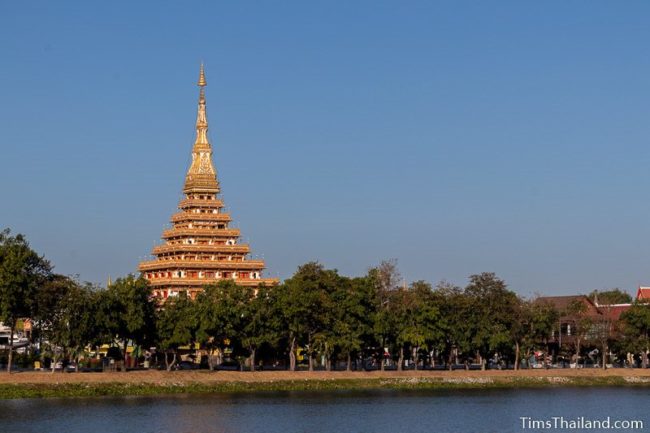
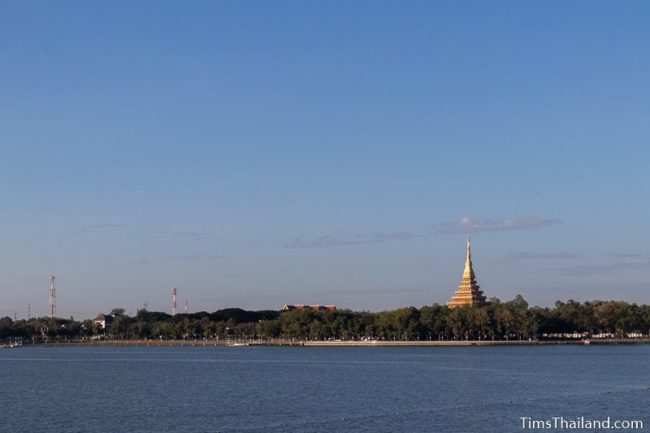
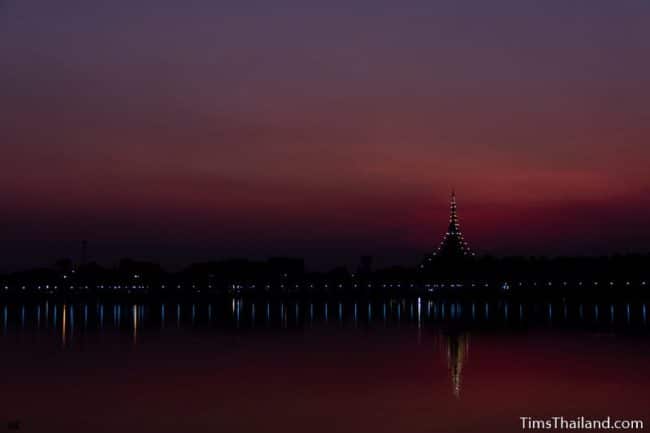
Phra Mahathat Kaen Nakhon
- The ground floor is open 6am-5pm and floors 2-9 are open 8am-4.30pm.
Phra Mahathat Kaen Nakhon stupa was built to celebrate both the king’s golden jubilee (celebration of 50 years on the throne) and the two hundredth birthday of Khon Kaen city. It is 50m long on the side and 80m tall and has nine floors because he was King Rama 9. Construction was started in 1990 and it was inaugurated in 1996.
The idea for the stupa came from the highly respected Luang Paw Koon Kantigo, the then abbot. The design was inspired by the Eiffel Tower and the Shwedagon Pagoda, both of which he saw while travelling. The most important of the abbot’s ideas, however, is the stupa’s curved shape, chosen to be that made by a hanging fishing net – called a catenary curve in physics.
People’s ashes are kept in the stupas at each of the four corners and the naga-topped wall around the stupa. Before construction, when this area was still rice field, a naga came to tell a high-ranking monk in a dream that there was a naga breathing hole where the stupa was going to be built. So, the stupa was built about 10m from the original intended location and these naga were incorporated into the design.
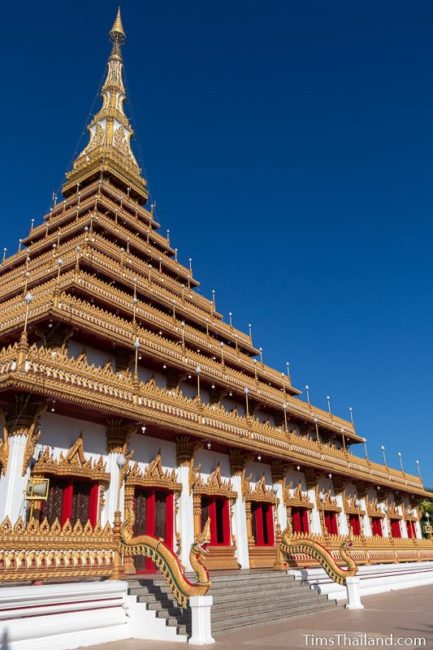
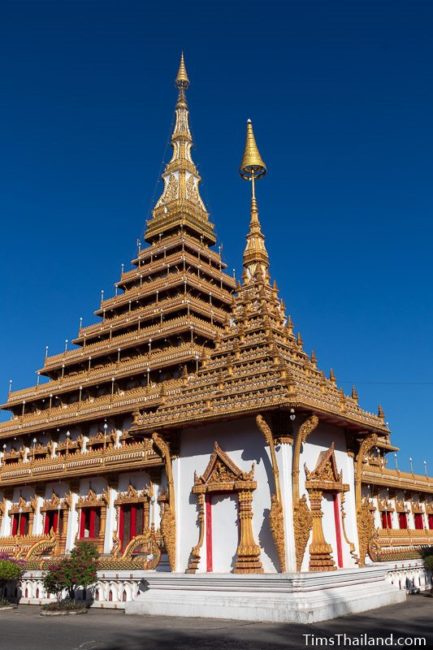
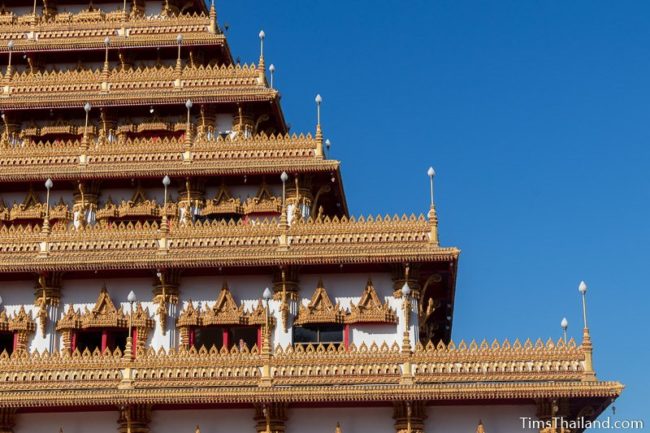
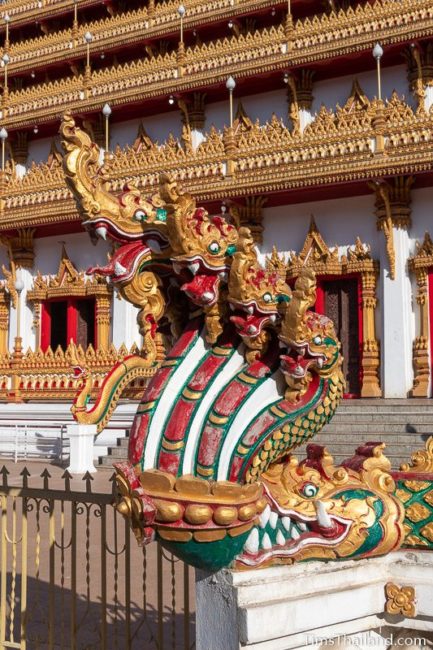
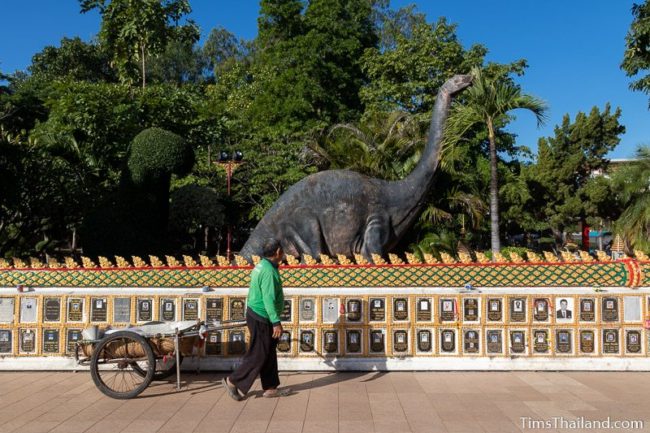
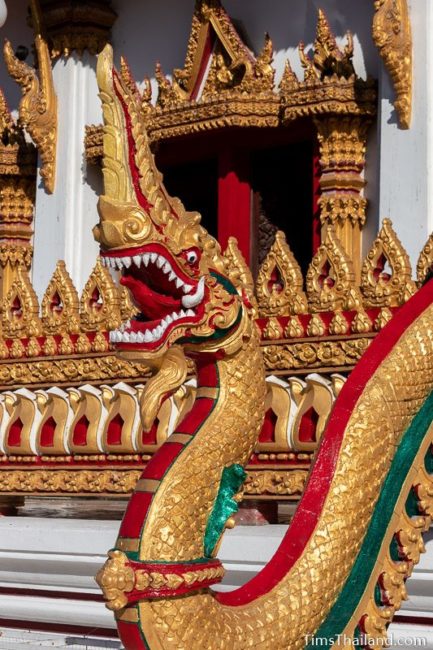
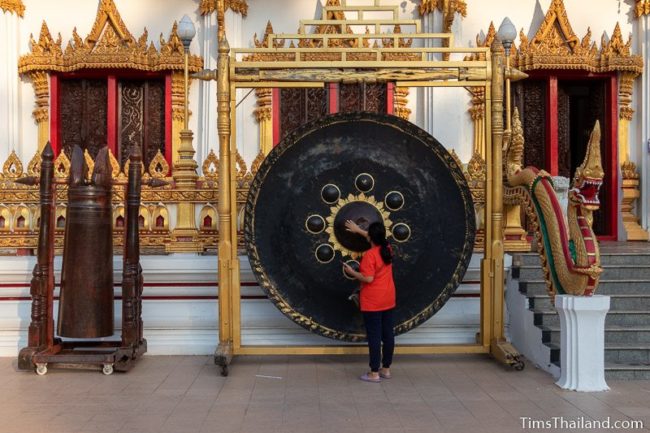
The shape of the top part of the stupa was inspired by Phra That Kham Kaen stupa (notice the redented corners) north of the city and has a golden-colored vine pattern similar to that on the very important Phra That Phanom stupa in Nakhon Phanom province.
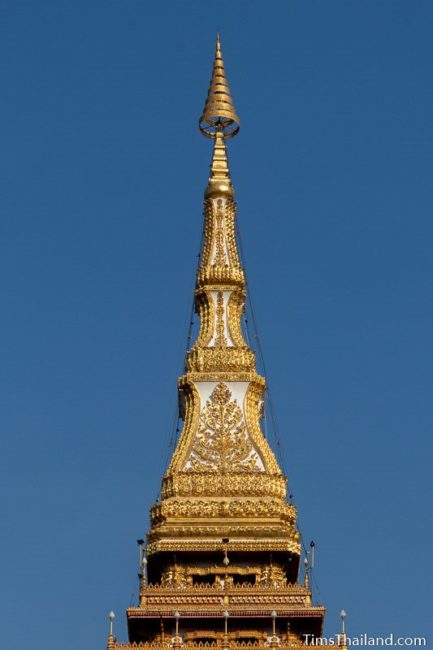
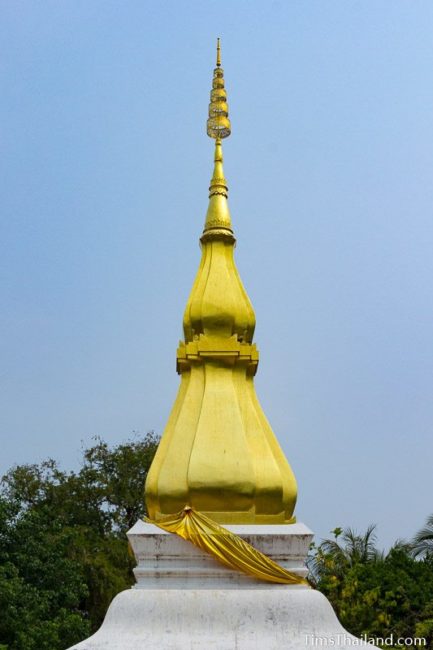
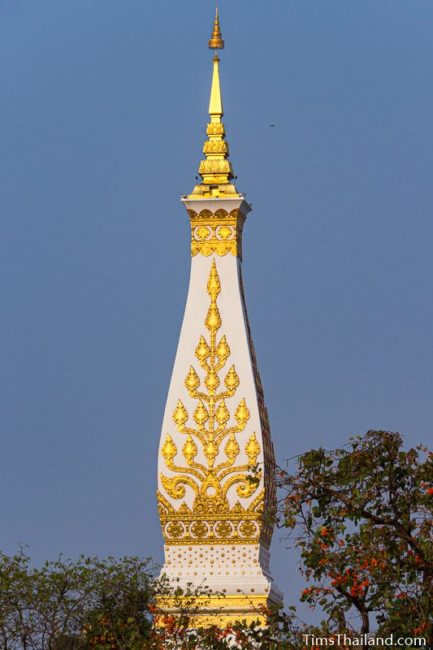
The walkway around the stupa has mosaic animals and zodiac (the Western one) signs. There’s a dinosaur playing the kaen (musical instrument made of bamboo) at three of the corners, and a kangaroo (just because) at the southeast corner. There are also similar mosaics on the walkways around the 2nd and 3rd floors.
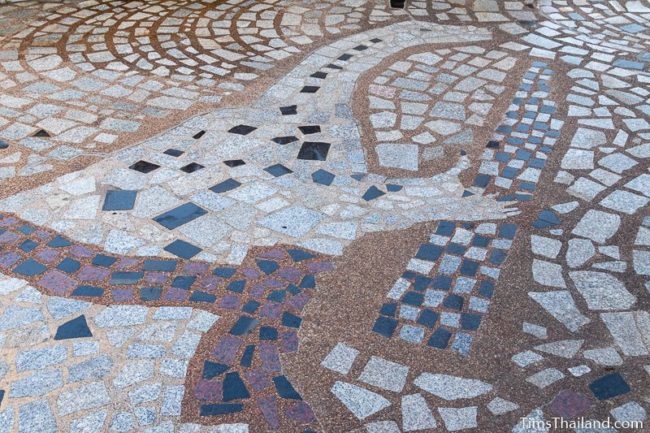
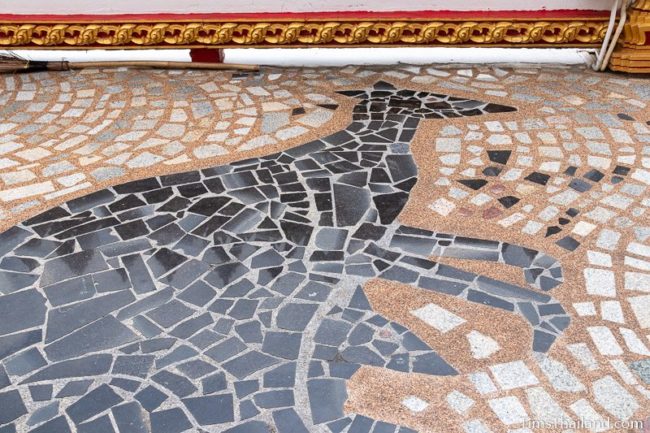
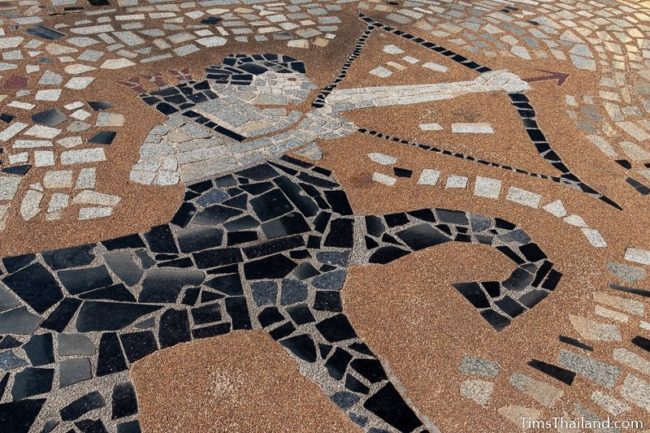
Ground Floor
The temple’s center of activity is the stupa’s ground floor, which has a Buddha relic inside a chamber with a nine-spired roof. Next to it is a life-like resin statue of Luang Paw Koon Kantigo, the previous abbot (Unusual, because these are normally made after an abbot has died, but this one was put here many years before.), and in the back is a copy of the Chinnarat Buddha (from Phitsanulok); two copies of Phra Kaew (the Emerald Buddha), one green and one orange; and a baby Buddha. They are facing west, rather than the usual east, because the original Chinnarat Buddha also faces west.
Along the northern wall is a table with 108 alms bowls (for donating 108 coins) and another full of daily Buddhas. The number 108 was important in ancient India and so it is found in many Buddhist stories, most importantly the 108 signs of perfection to show that he was the Buddha – this is also why there are often 108 symbols on the soles of many large Buddha footprints.
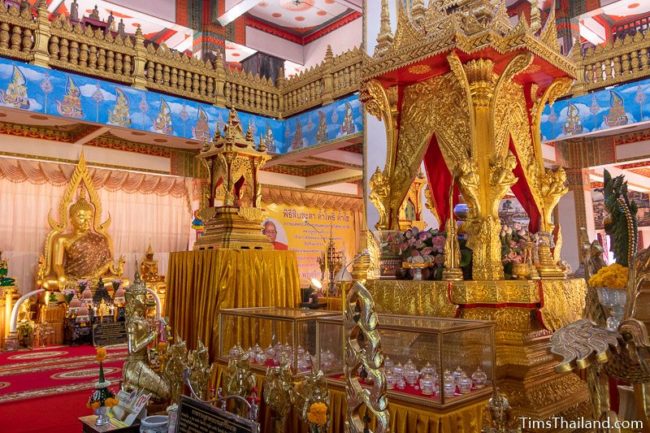
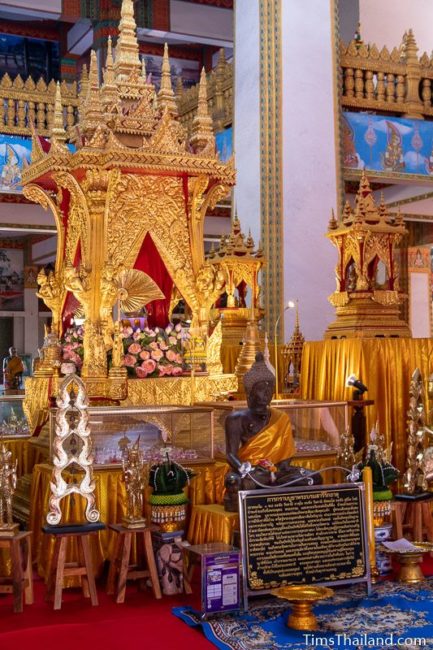
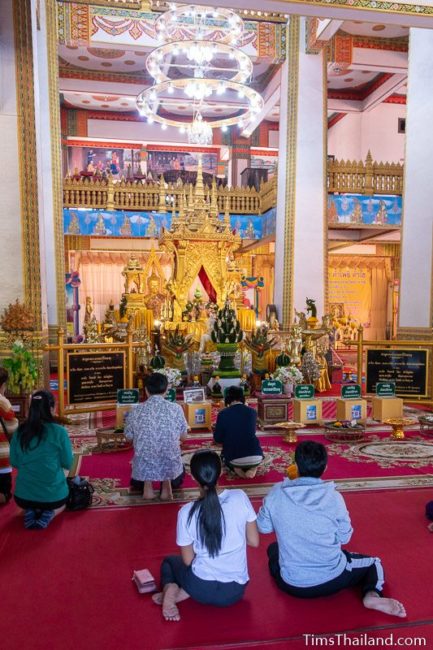
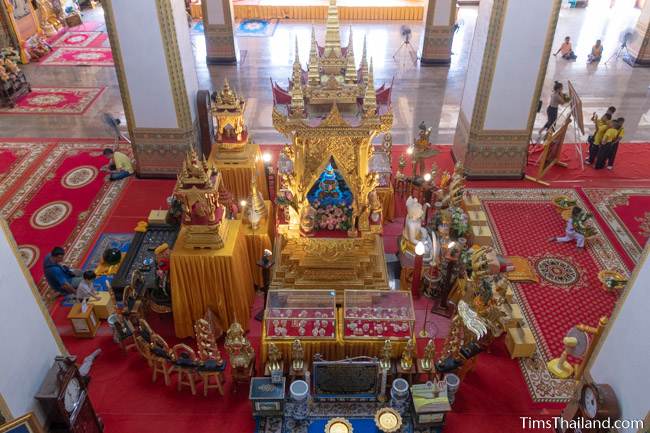
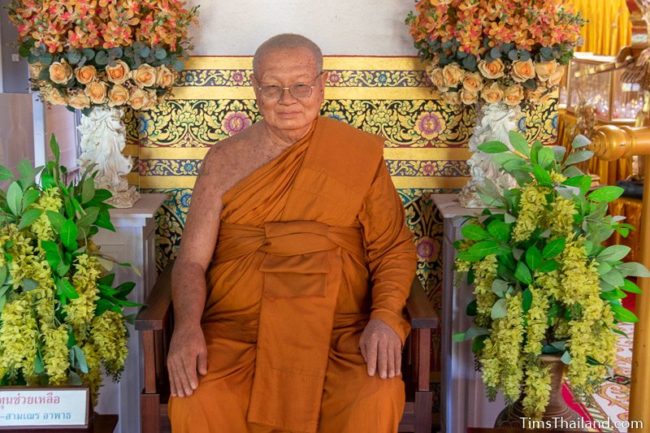
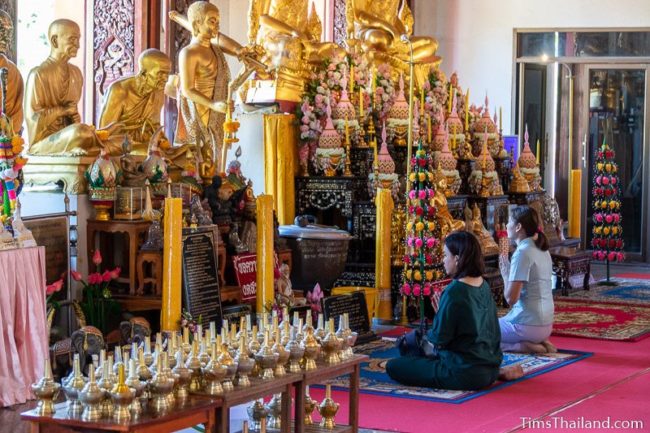
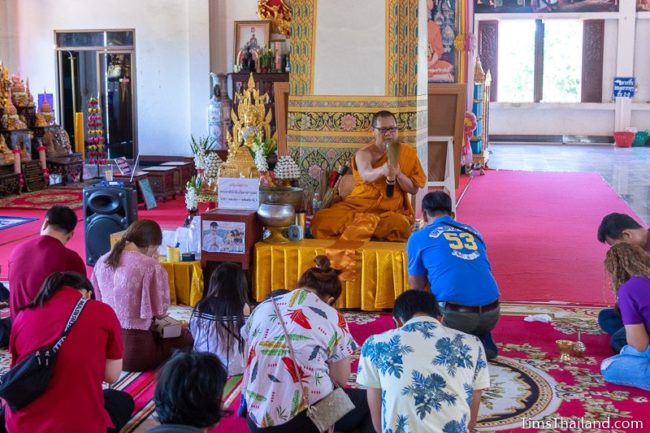
The wall murals (starting in the southeast corner) tell the history of Khon Kaen city – painting #5 shows the settlers arriving at this location – followed by panels about Isan culture, including Heet 12-Khong 14 festivals and social rules. Many of the painting here and on other floors have funny little scenes hidden in plain sight, such as the little boy peeing in picture #26.
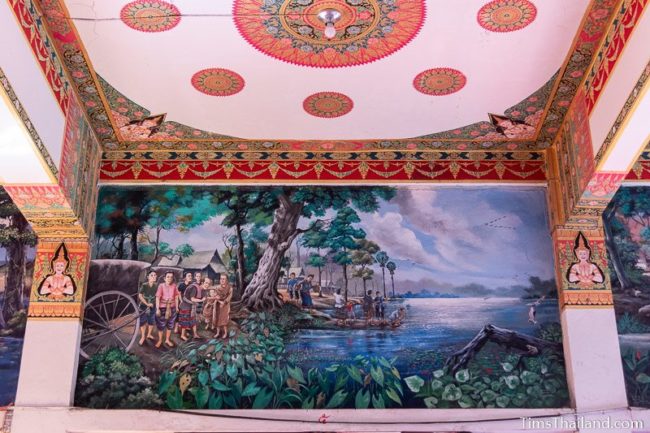
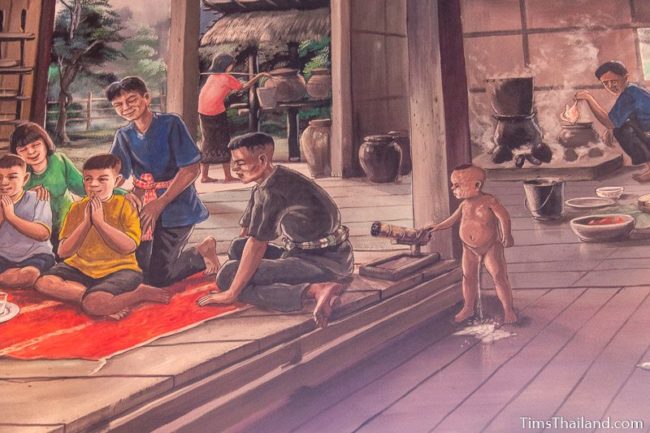
The carved wooden doors and window shutters tell the Four Jampa Trees folktale, which is about how if you do good things you will have a good result and if you do bad things you will have a bad result.
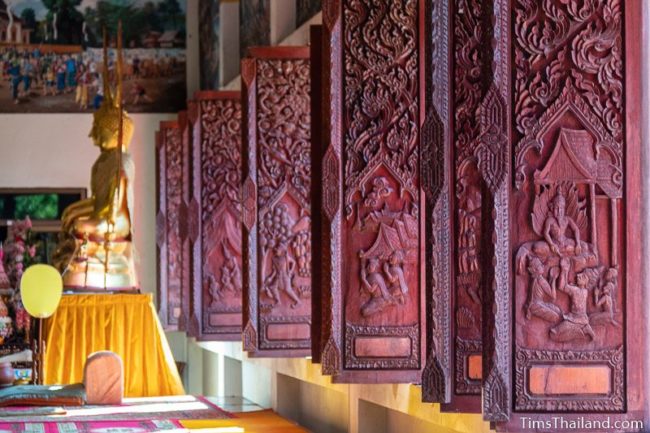
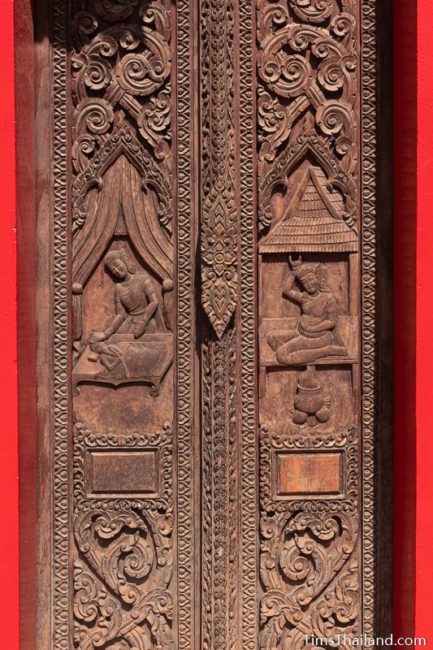
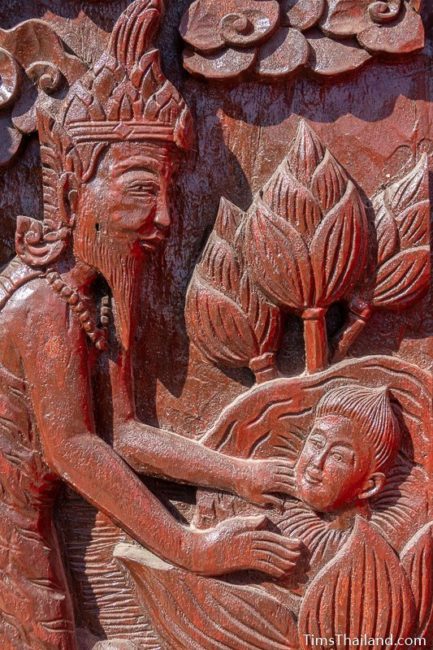
2nd Floor
The second floor holds a small Isan cultural museum with a hodgepodge of things including basketry, Ban Chiang-style pottery, palm-leaf manuscripts, animal traps, and musical instruments.
The wall murals are about kalam (Isan prohibitions) and the painted doors and window shutters show the Sin Sai folktale.
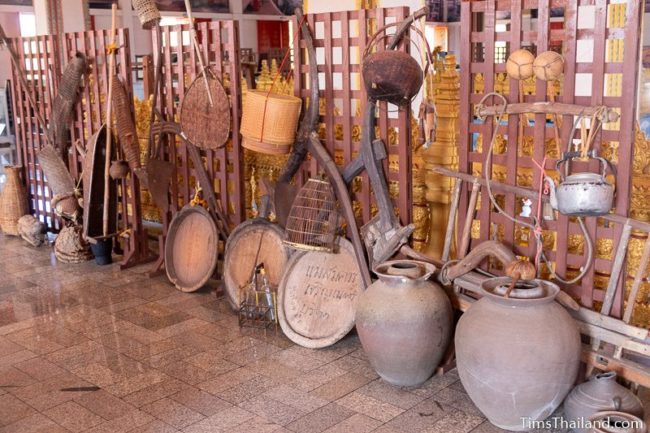
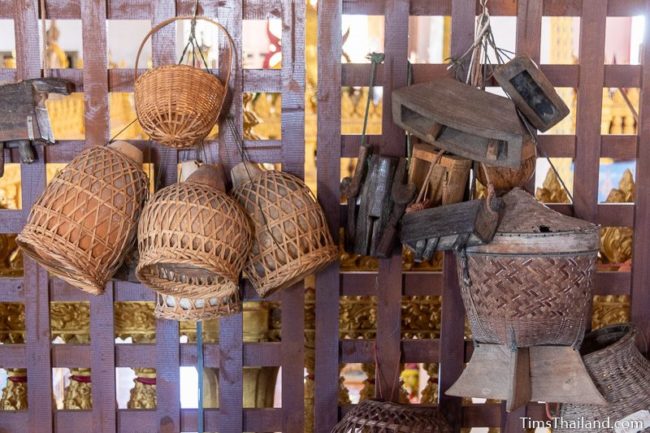
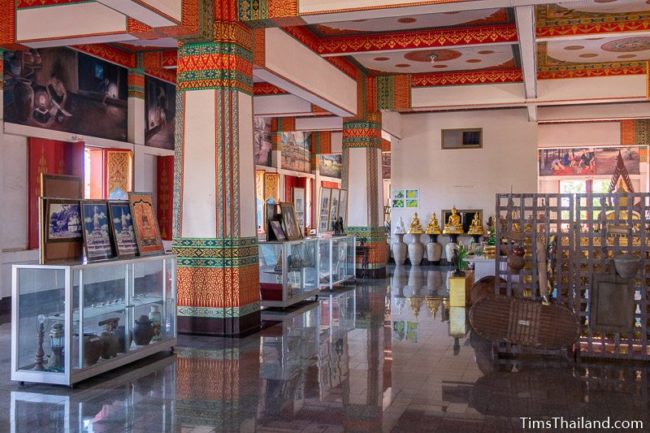
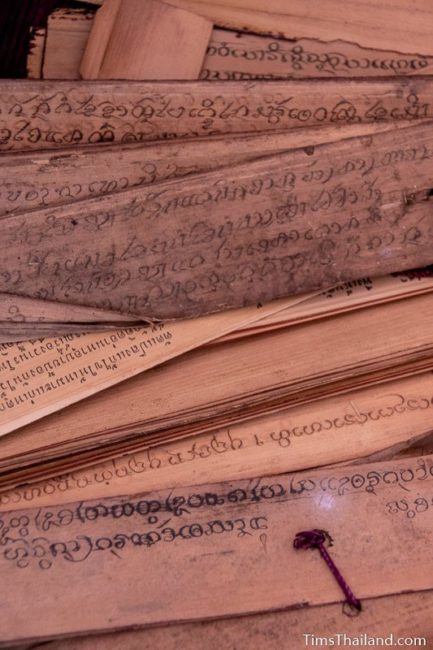
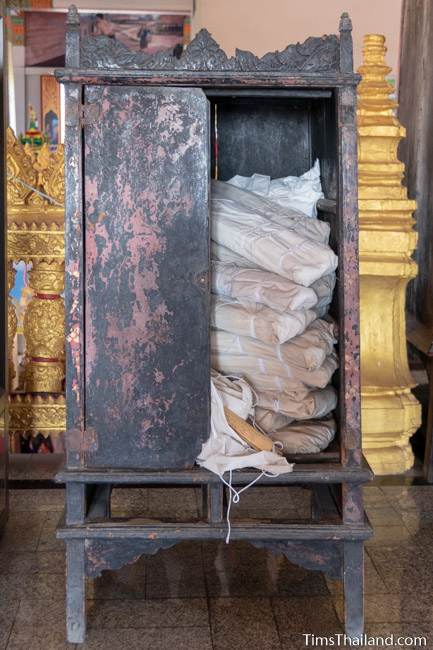
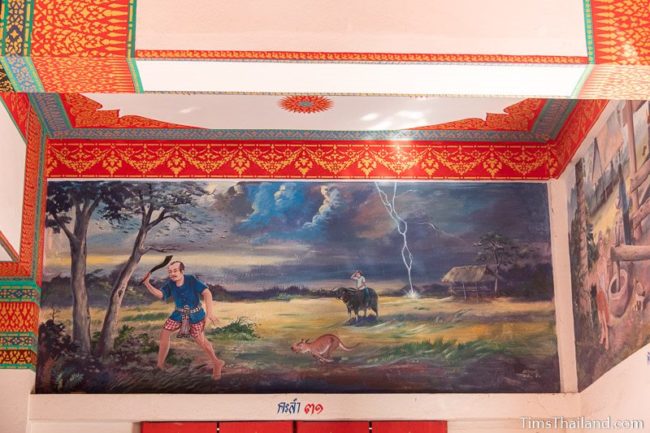
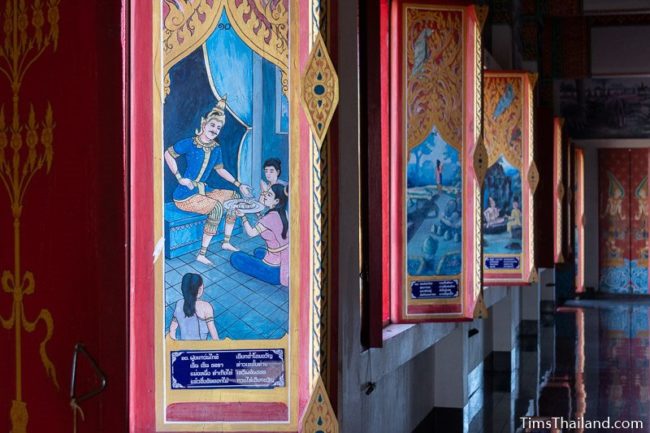
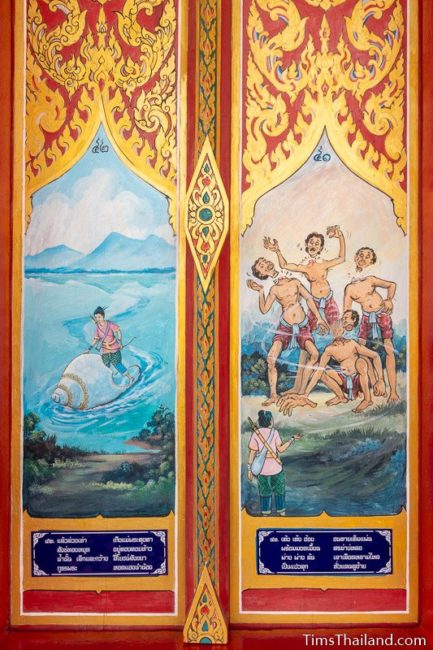
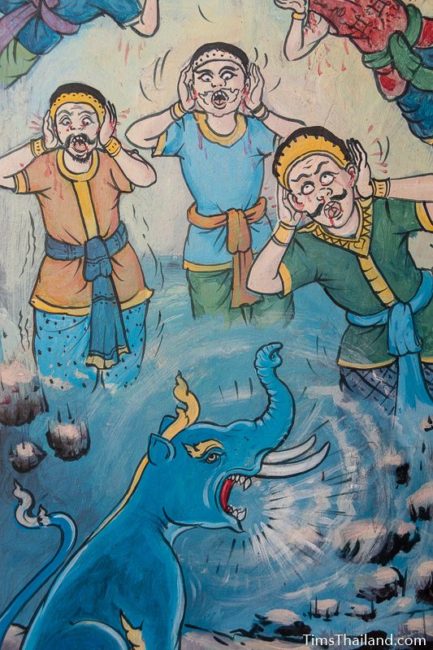
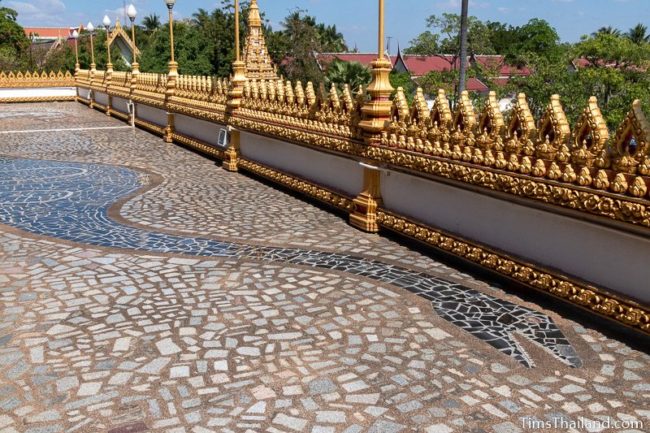
3rd Floor
The third floor displays some decorative items like nielloware bowls, shells, and tea cups, plus a whole lot of monk fans. One display case has many lek lai magical rocks.
The wall murals are a unique rendering of the Vessantara Jataka set in Isan and the painted doors and window shutters tell the Nang Pom Hom (“Lady with Fragrant Hair”) story.
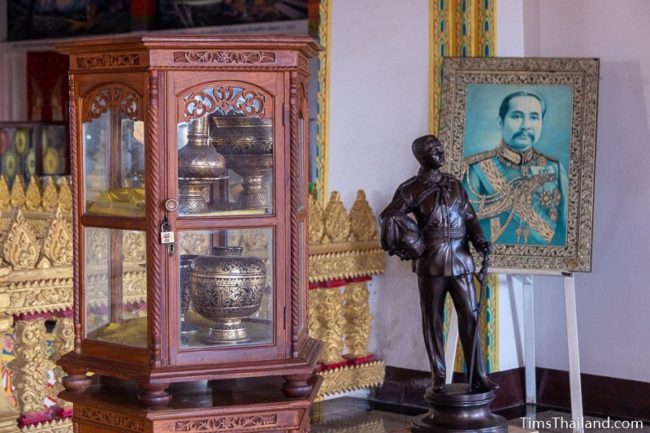
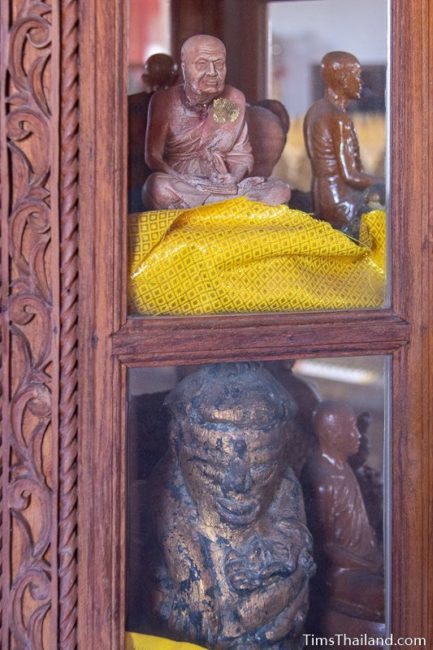
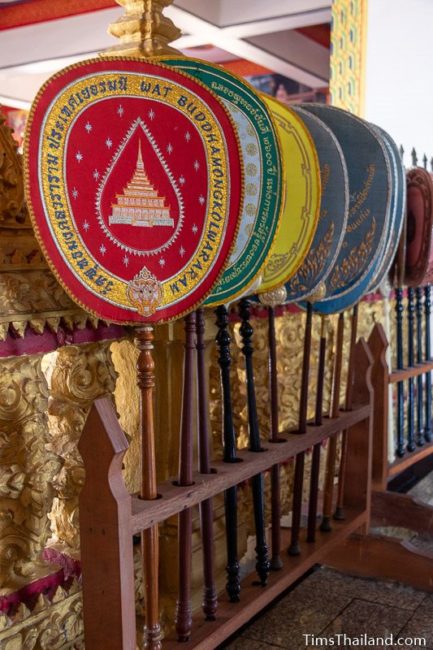
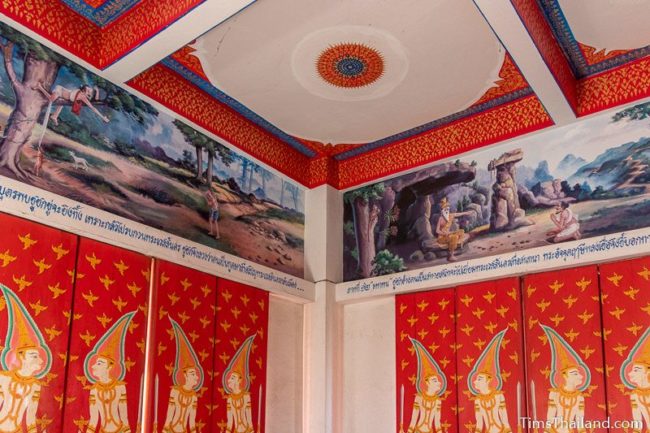
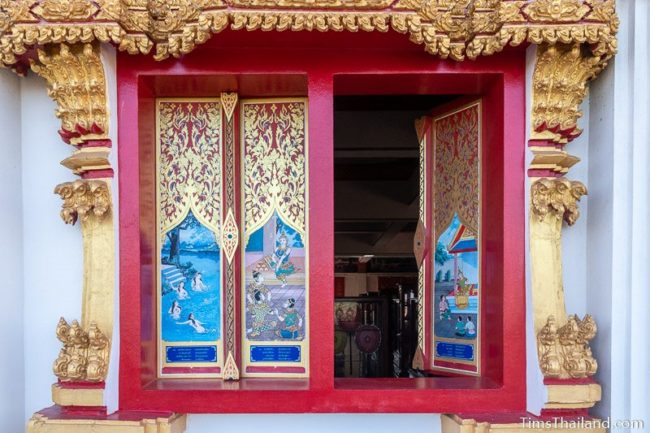
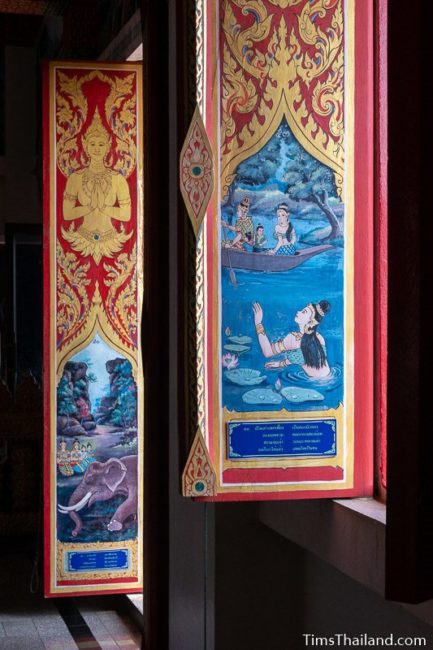
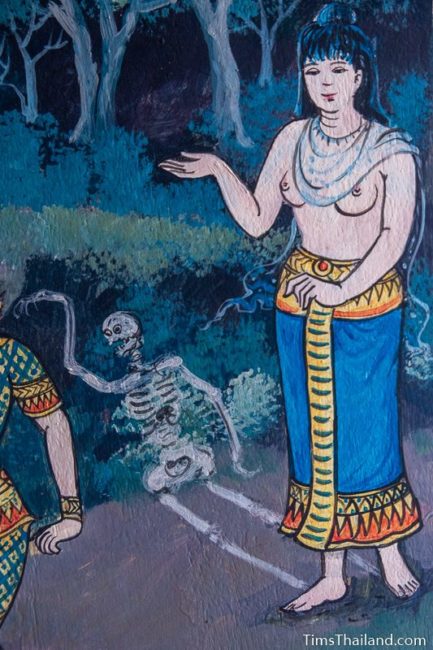
4th Floor
The fourth floor displays a collection of Buddha images and other Buddhist sculpture in many different ages and styles. The long cabinet near the south wall has nothing of ascetic value, but there are many rarely seen postures.
The wall murals are a biography of the former abbot, Luang Paw Koon Kantigo, (The two large pictures in the room are of him too.) and have scenes of him going to school, working his family farm, visiting Germany, and building Phra Mahathat Kaen Nakhon stupa. The painted doors and window shutters depict the daily Buddhas, the gods of directions and planets, and the animals associated with the directions in Isan culture.
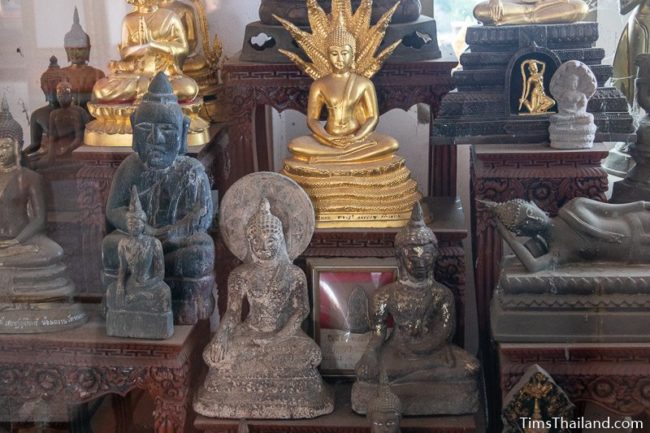
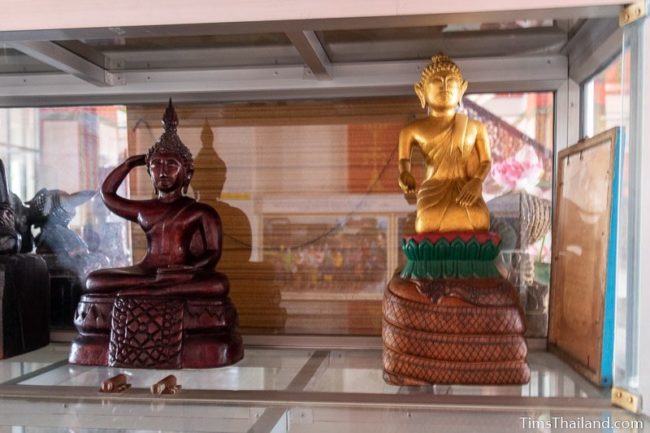
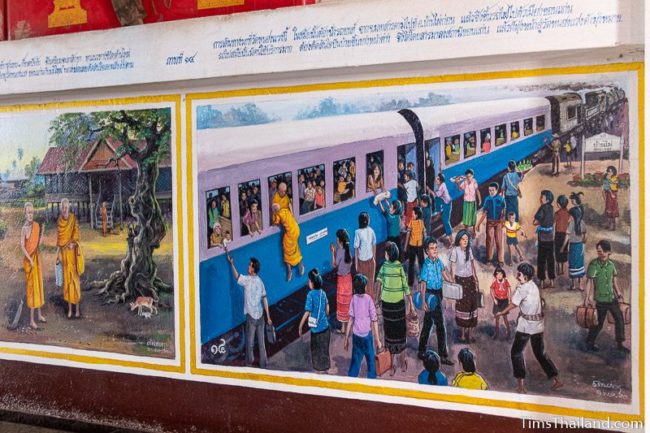
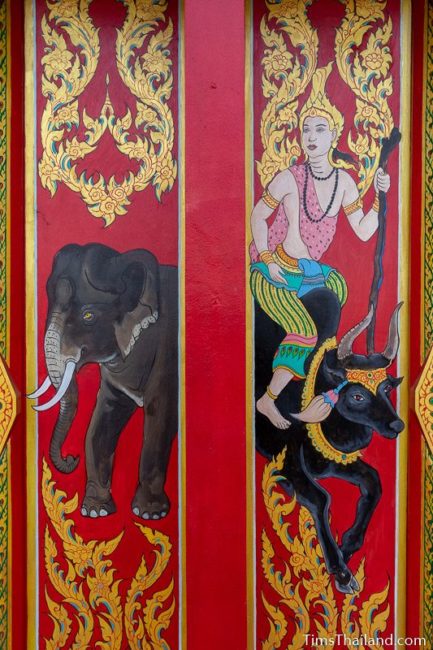
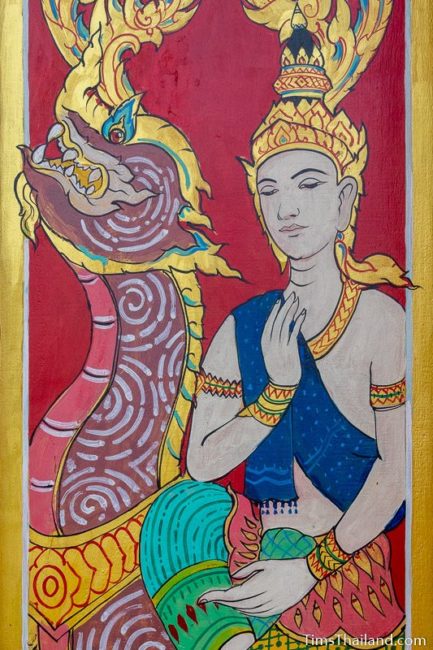
5th Floor
The fifth floor holds some of the belongings (like dishes and books) of Luang Pu Phraku Palad Budsaba (Bong Sumano), Wat Nong Wang’s fifth abbot. (His picture is on the bed with the typewriters.) The big photo next to the coffin is not him, but rather Luang Pu Maa Yanwaro from Roi Et, a close friend of the previous abbot, Luang Paw Koon Kantigo. He once did some sort of personal long-life ceremony here that used this coffin, and so it remains.
The wall murals show Isan proverbs and the carved wooden doors and window shutters depict stories from the latter half of the Buddha’s life, including Angulimala and Devadatta trying to kill him.
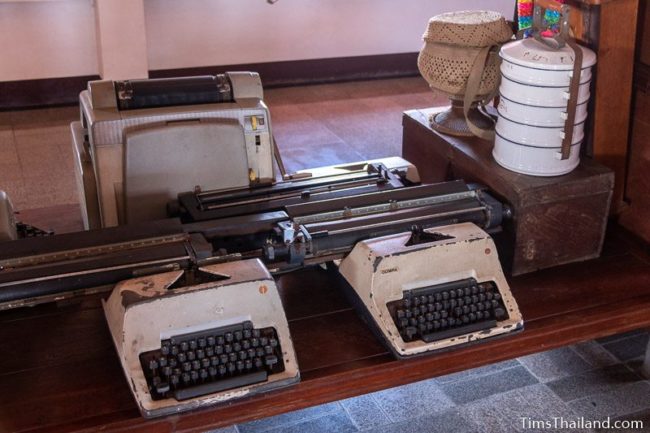
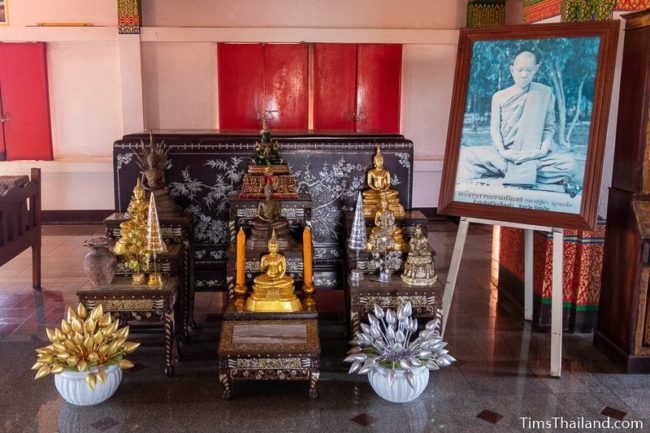
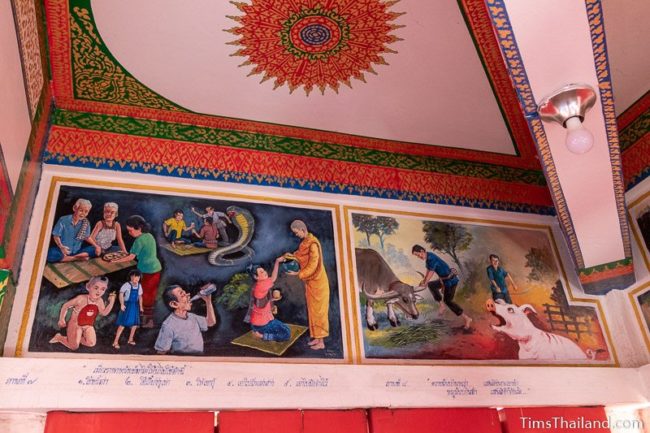
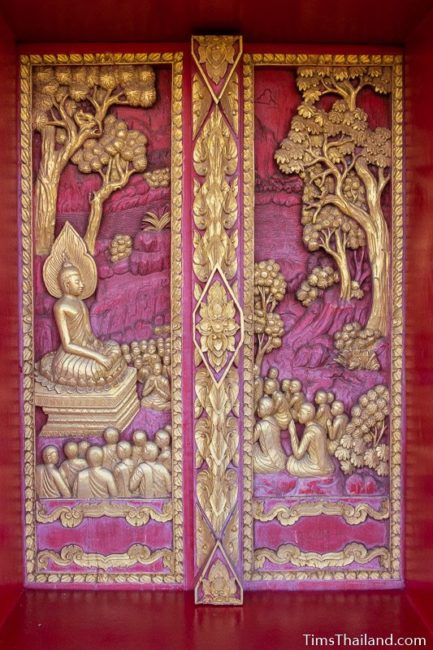
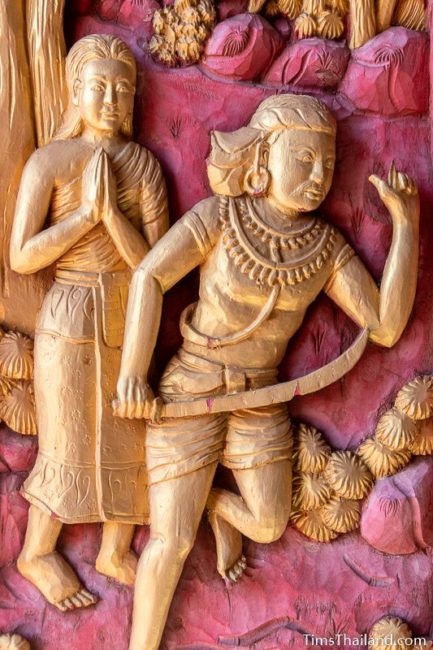
6th Floor
The sixth floor has bronze statues of monks who were some of Luang Paw Koon Kantigo’s (the previous abbot) teachers. His statue is at the end of the line, separated from the others by the wooden Vishnu statue.
The wall murals presently being painted show moral lessons (kadi-tam) from famous monks in Khon Kaen. The carved wooden doors depict stories from the first half of the Buddha’s life, including his birth, Great Renunciation (the beginning of his quest to find the way to end suffering), and enlightenment.
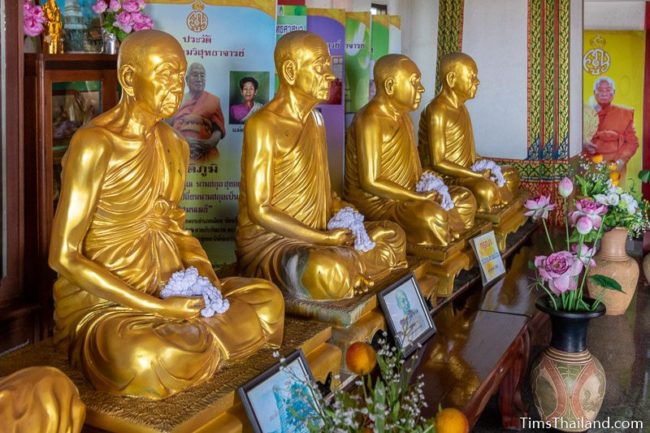
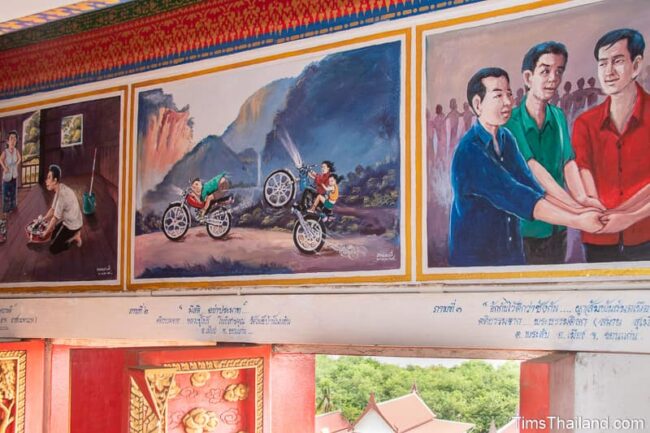
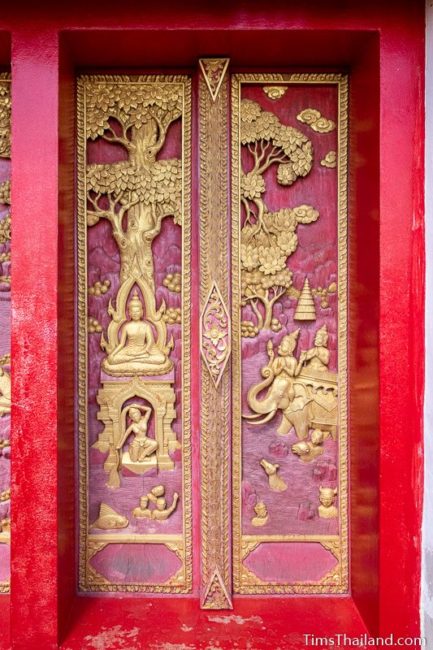
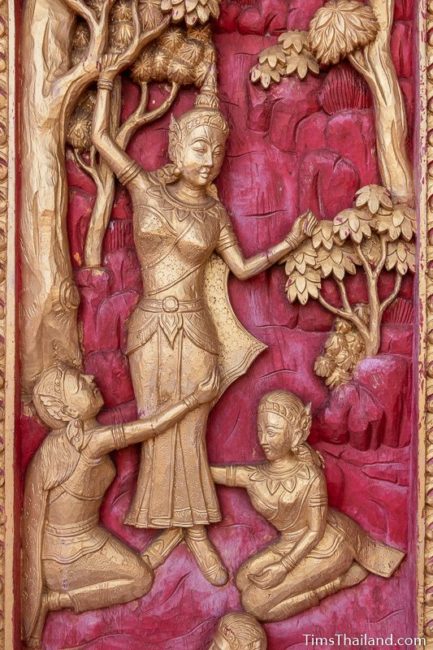
7th Floor
The seventh floor features a small Budai shrine and a bronze bell.
The carved wooden doors and window shutters tell the Mahanipata Jataka tales, the last ten lives of the Bodhisatta (the Buddha-to-be) before he was born as Prince Siddhattha and was able to reach enlightenment.
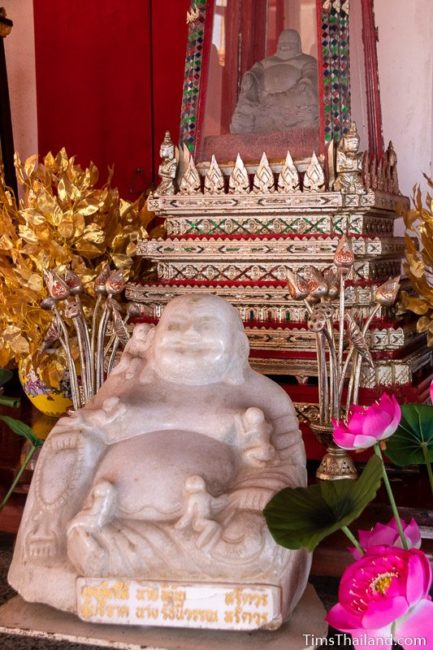
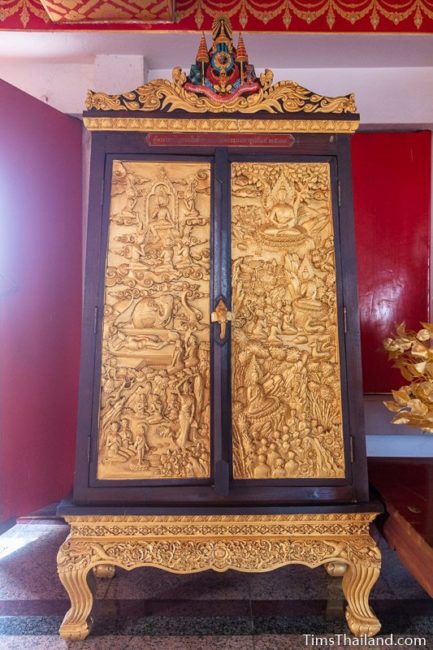
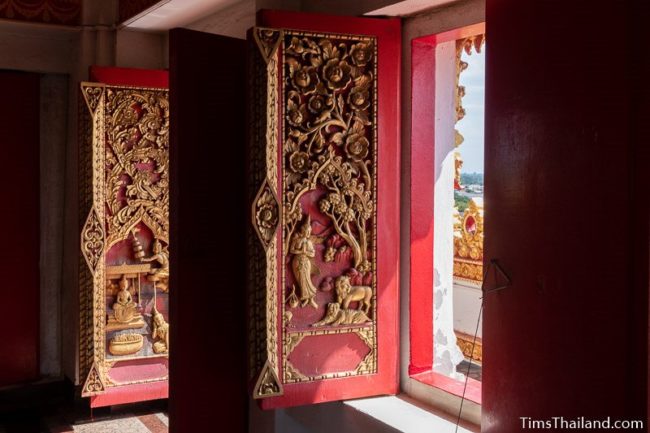
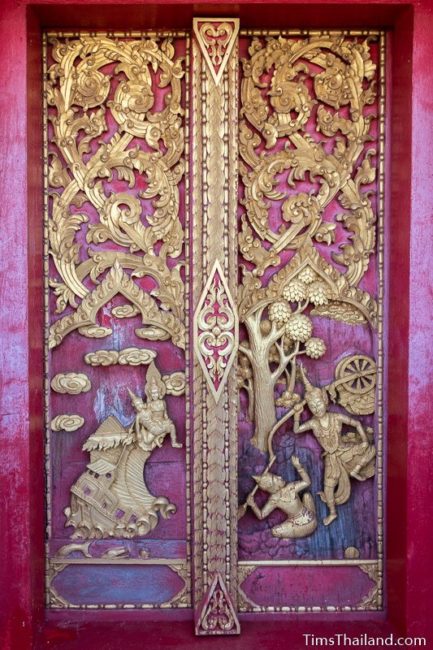
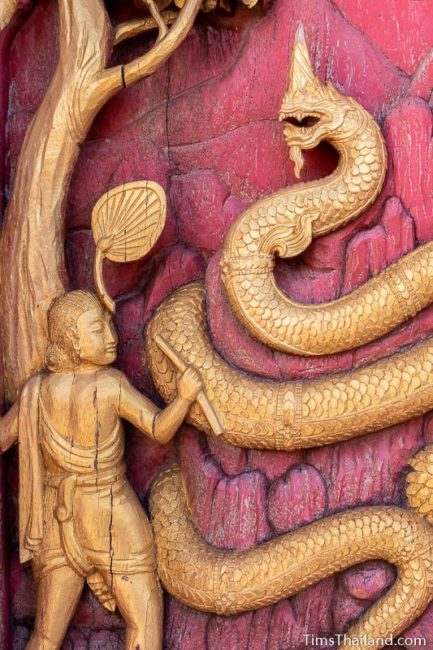
8th Floor
The eighth floor has two cabinets holding three sets of the tripitaka.
The carved wooden doors depict the sixteen levels of “sense-sphere heavens” where gods still have form, though they are invisible.
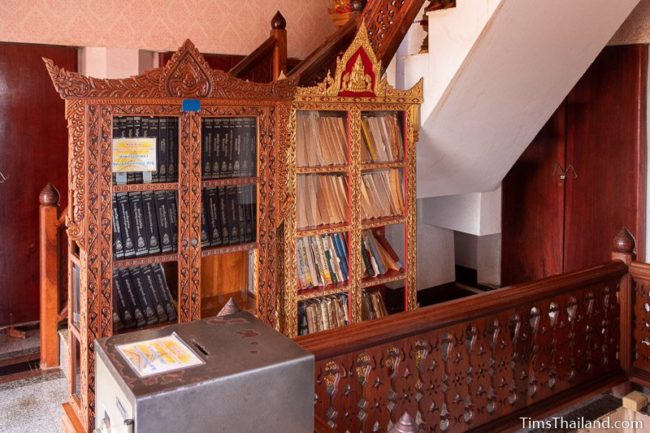
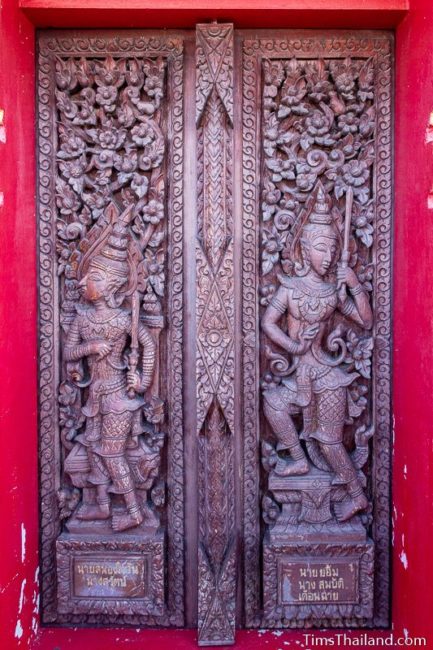
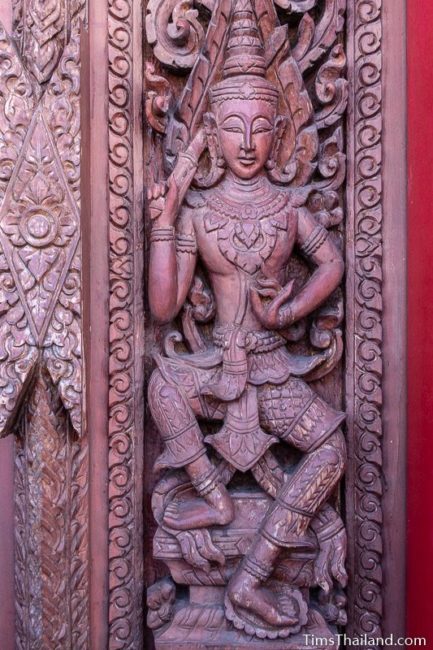
9th Floor
The ninth floor has the stupa’s second Buddha relic. It’s in a small copy of the nine-spired chamber on the first floor. From here you can walk around and see a big 360-degree view of Khon Kaen city and Bueng Kaen Nakhon lake; although it can get a little crowded, so the eighth floor is often the better viewpoint. The cluster of red roofs to the northeast of the stupa are the monk quarters.
The carved wooden doors depict the four “formless heavens” where dwellers exist only as consciousness in pure bliss. These are the highest heavens, but still below Nirvana.
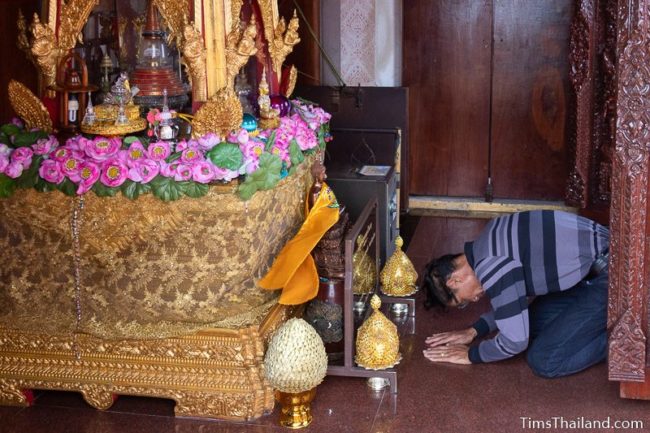
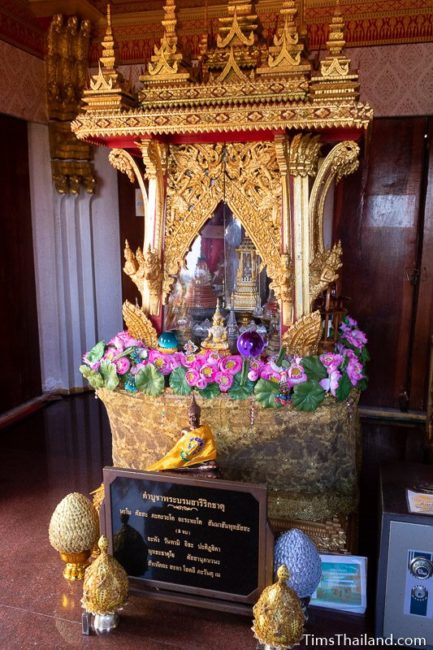
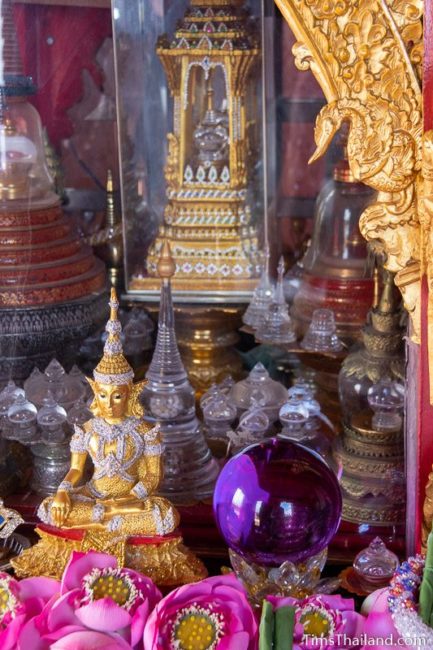
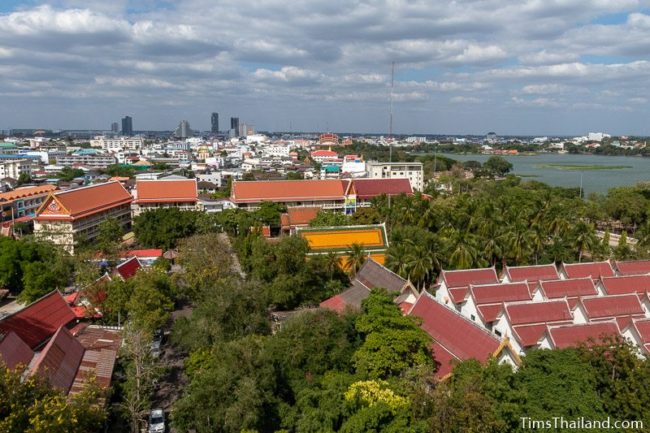
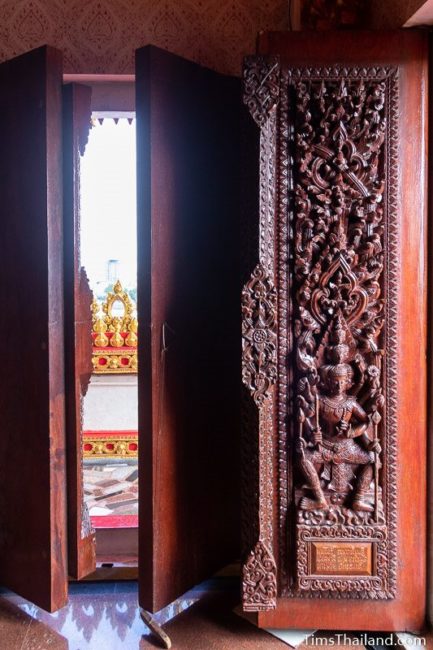
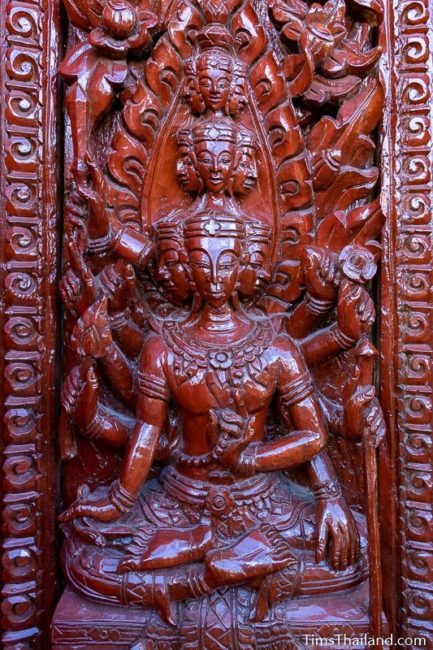
Other Buildings
New Ubosot
Not a typical ubosot, Wat Nong Wang’s ordination hall has a simple, cross-shaped design with lots of glass doors and windows. It was built as a wihan, but when Wat Nong Wang became a royal temple a bigger space was needed (Ubosots of royal temples must have five windows on each side.) and it was converted. Inside above the main Buddha there are paintings of heaven and to the east is Buddha coming down from Tavatimsa Heaven and opening the three worlds.
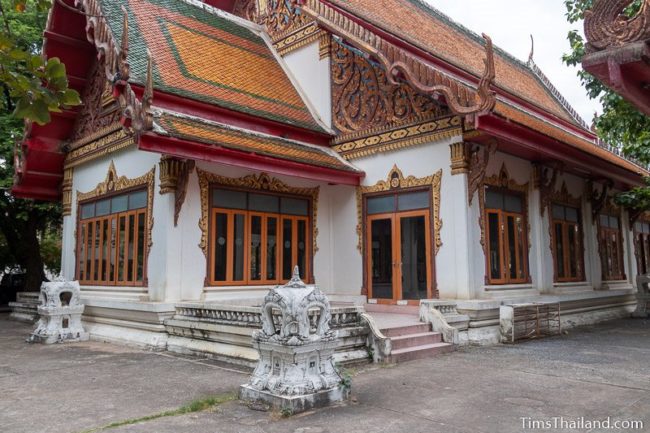
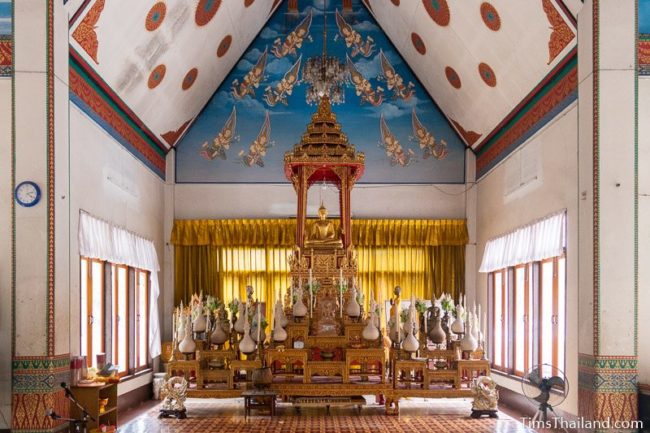
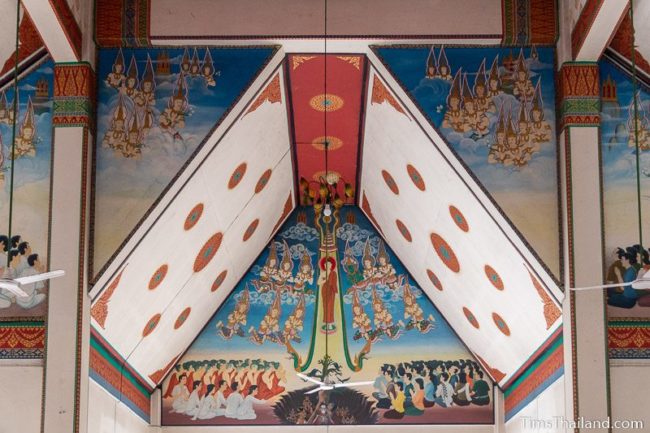
Monks chant here in the morning (7.30am) and novices chant in the afternoon (5.30pm) – except on monk days, when chanting is done in the stupa.
The bell (made from the top of a US bomb form the Vietnam War) hanging from a tree at the southwest corner is the bell used for signaling the monks throughout the day rather than either of the bell towers behind the old ubosot.
Just to the east is a sculpture of hands holding up a log that honors Phra That Kham Kaen, a holy stupa outside the city.
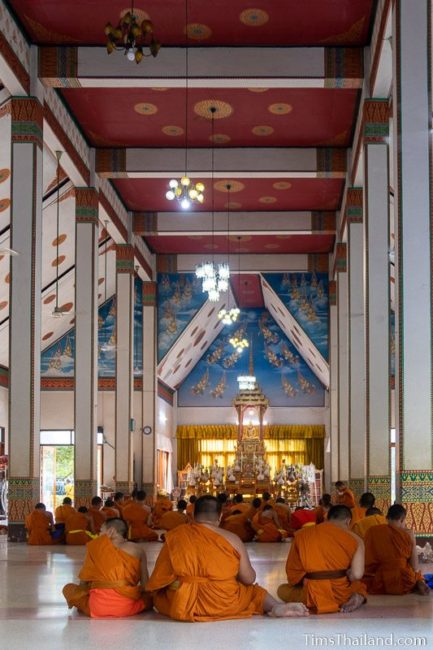
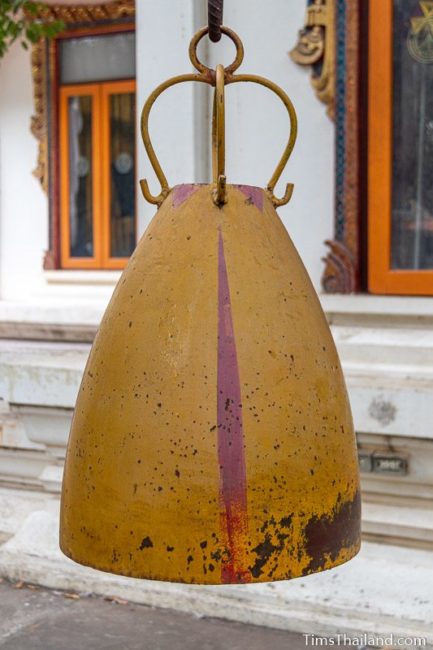
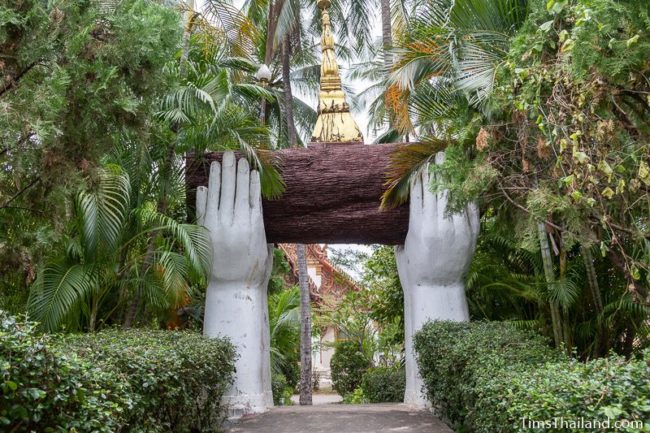
Old Ubosot
The previous, and no longer used, ubosot is classic central Thai style, tall and with lots of mosaic. In the back (west side) there is a Buddha image inside a glass chamber and a Brahma statue in front of the glass. It’s kept closed at all times.
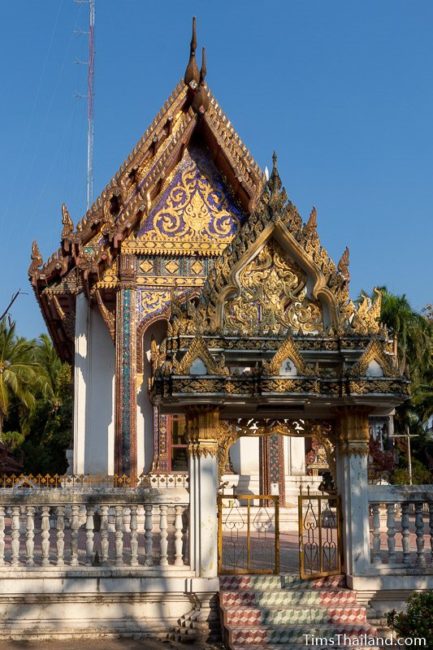
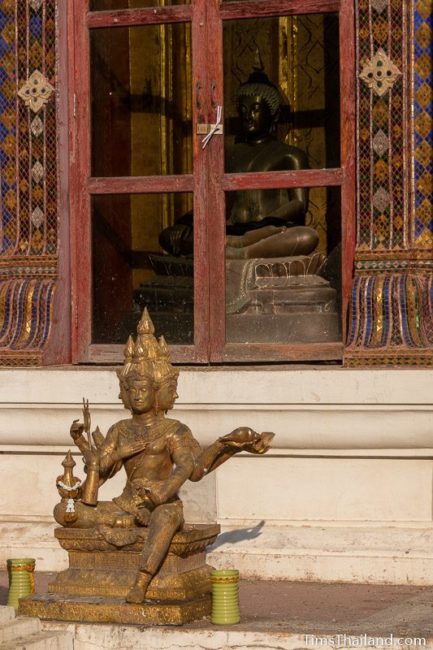
Wihans
Between the ubosots are back-to-back wihans with a bodhi tree between them. The slightly larger western one is used for personal worship; the other is now just used for storage. The main one has a Boy Scout logo on the pediment because money to construct it was raised by boy scouts. The monk statue inside glass is Luang Pu Phraku Palad Budsaba Sumno, the same former abbot memorialized on the stupa’s fifth floor.
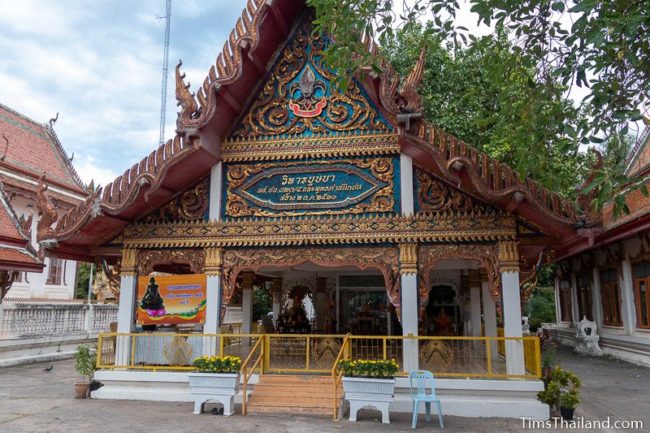
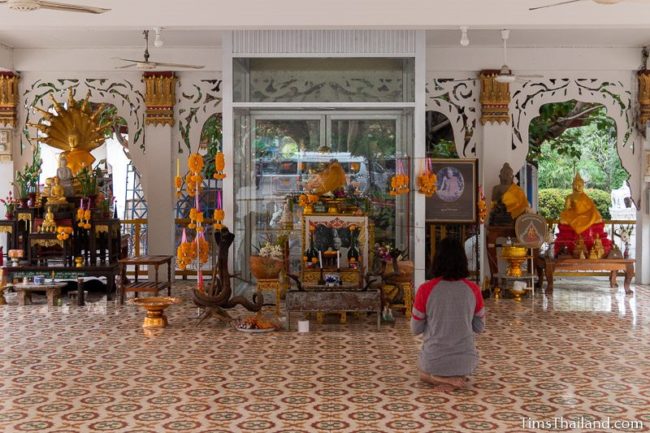
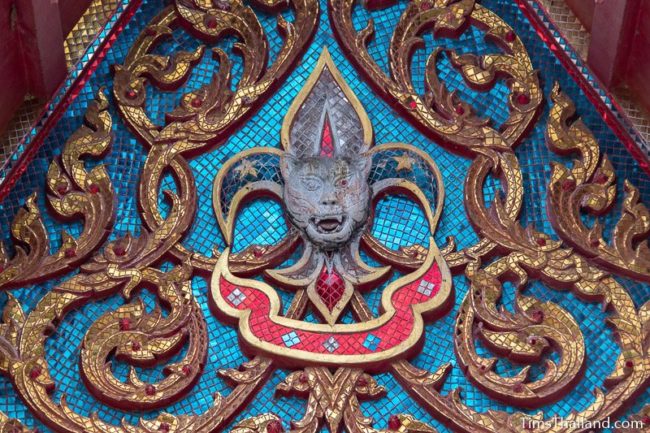
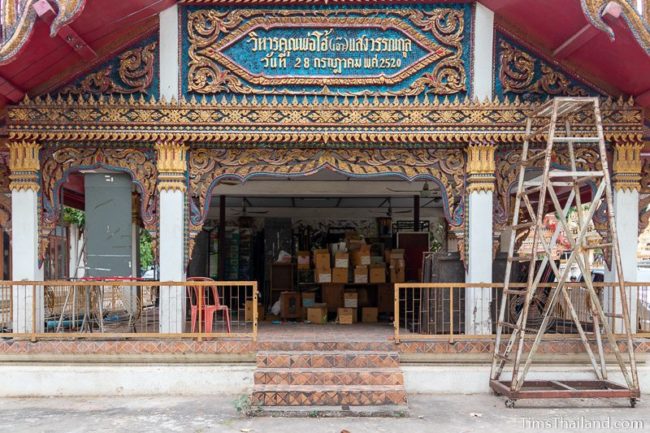
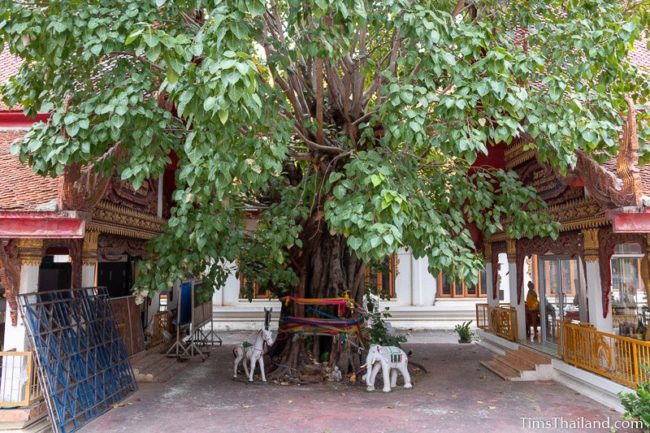
Crematorium
It’s just an ordinary Thai crematorium, except there are pictures of heaven and hell under the roof in front.
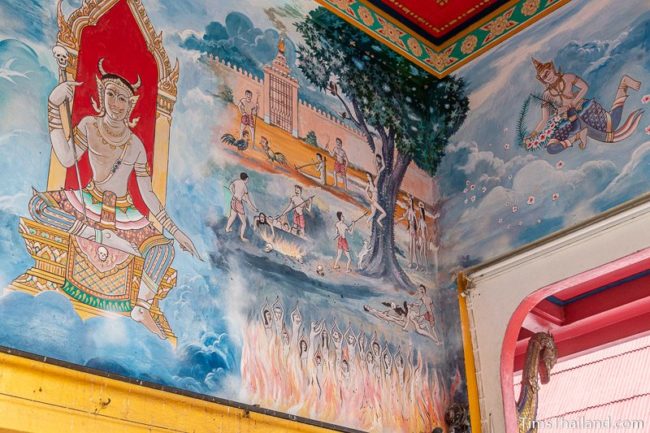
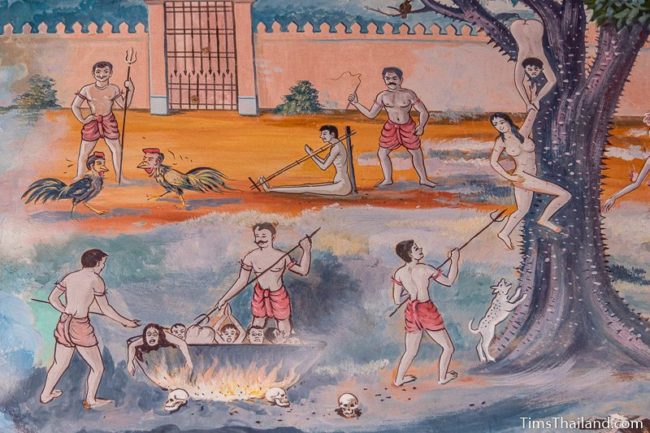
Schools
Money the temple collects is used to support three schools for poor students. Nearest the stupa, at the southeast corner, is a high school. At the north edge of the temple is a K-6 elementary school and also a high school for novices where they study Pali and dharma in the morning and regular school subjects in the afternoon.
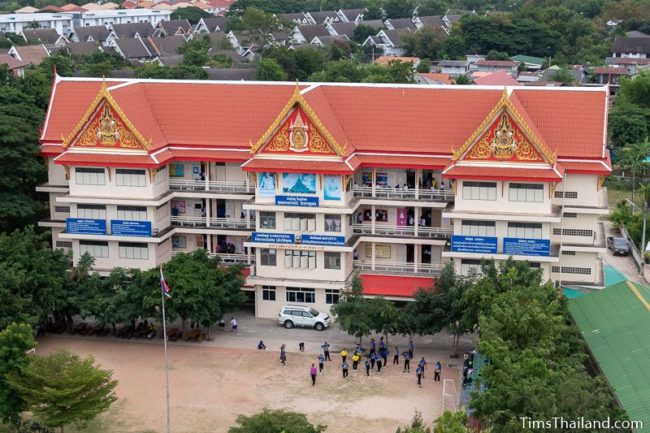
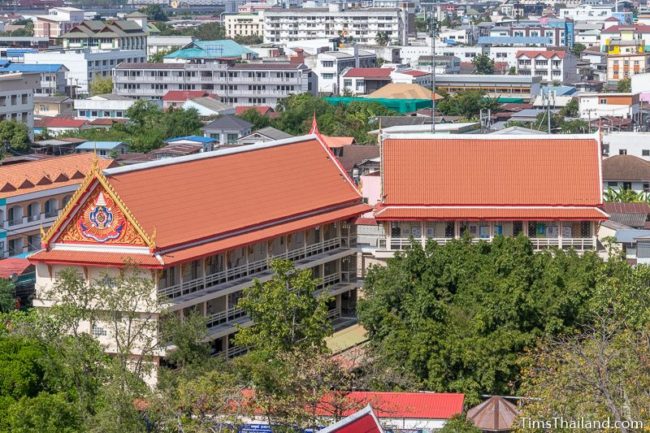
Health Center
The temple also uses some of its donations to run a health center for poor people.
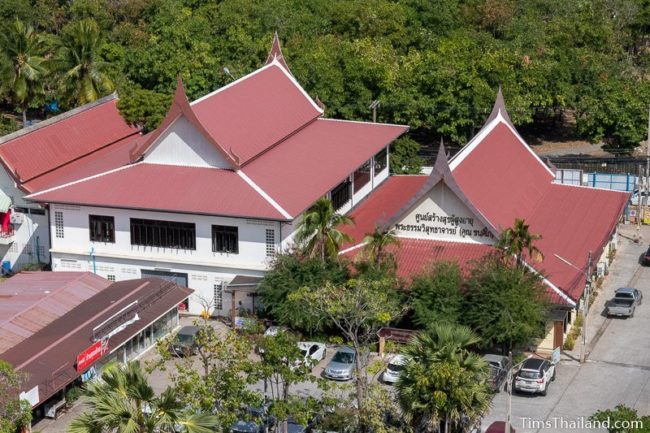
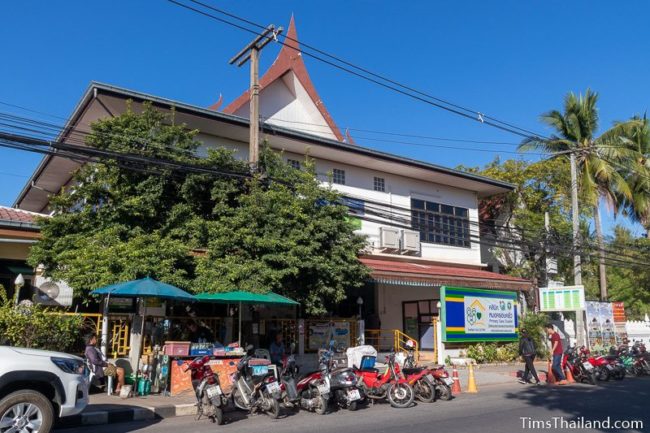
One thought on “Wat Nong Wang”
I loved being a Monk here, 2006, Monk Khon will never be forgotten , I was from California, now I am from Wat Nong Wang. Ajon Khant Palo Darma. Thank You So Much